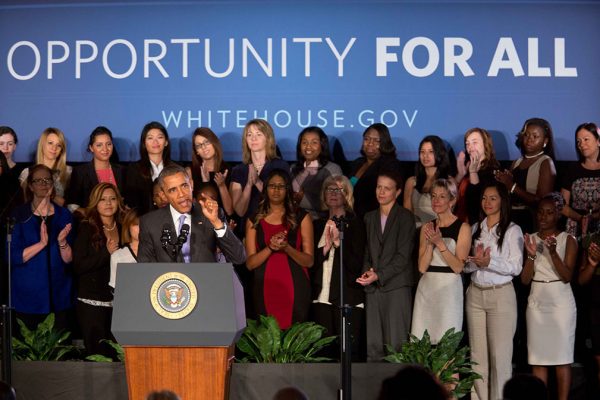Jacob Hacker and Paul Pierson consider it “puzzling” that the Democratic Party has pursued an ambitious progressive economic agenda even as they have “sought out and won over an increasing share of affluent suburban voters.” But why should the party’s “move up the income distribution” entail “closing the door on ambitious economic reforms”? The assumption here is a perennial favorite among political economists: policy preferences are determined by economic self-interest. But for better or worse, they’re mostly not. As one influential review of the relevant evidence put it, “Self-interest ordinarily does not have much effect upon the ordinary citizen’s sociopolitical attitudes.”
The 2020 Nationscape survey gauged the policy preferences of 55,000 people in the three months after the 2020 election. Dividing the respondents by party and income quintile reveals remarkably little opposition to the Biden administration’s “surprisingly ambitious” economic agenda among affluent Democrats—or for that matter, much relationship at all between income and economic policy preferences. Ensuring that all students can graduate from state colleges debt-free was a bit less popular among affluent Democrats than others, but the difference was modest. Large-scale investment in environmental technology—one of the most ambitious items on the Biden agenda—was more popular among affluent Democrats than among those in the bottom two income quintiles, but here too, the difference was modest.
The absence of any significant income gradient in Democrats’ economic policy preferences undercuts the premise of Hacker and Pierson’s “puzzle.” But another striking fact is that, regardless of income, Democrats at the beginning of the Biden administration were strongly supportive of all these proposals. Even “government-run health insurance” for all—a much more ambitious progressive policy than any the Biden Democrats have tried to pass—was overwhelmingly supported by Democrats across the income spectrum; among those in the top two income quintiles, 70 percent agreed and only 15 percent disagreed. The proposal with the weakest support was “strengthening unions,” but even in that case fewer than 20 percent of Democrats were opposed, and their views were unrelated to their own economic positions.
According to Hacker and Pierson, “many political scientists would concur” that an increasingly upscale Democratic Party should “pivot from economic issues—which divide its voters—to cultural ones.” That advice is precisely backward. In the contemporary party system, Democrats are united by their support for big government and progressive economic policies, but they are divided on cultural, social, and racial issues. (Republicans, conversely, are united by cultural conservatism but divided in their support for laissez-faire economics.) For example, Democrats in the Nationscape survey were roughly evenly divided on allowing the Ten Commandments to be displayed in public schools, substantially increasing funding for border security, and requiring a waiting period for abortions. Substantial pluralities opposed allowing racial preferences in higher education and decreasing the size of police forces. On these and other contentious issues, the Democratic Party’s affluent professionals—including “many political scientists”—err in imagining that their own views are representative of the broader rank and file’s.
What about affluent Democrats’ “worry that it is they who will foot the bill for expensive new programs”? Democratic politicians have spent the past fifteen years pandering to that concern, promising all but the richest taxpayers that their taxes would not be raised. The Nationscape survey data help illuminate the reality, the nature, and the limits of the potential backlash against high taxes.
The survey included four questions tapping support for progressive taxation. One, contrary to any reasonable calculation of economic self-interest, revealed support for eliminating the estate tax among Democrats at all income levels; if anything, that support was slightly stronger among those in the middle- and lower-income quintiles. The other questions revealed varying degrees of support for more progressive tax policies. Democrats across the income spectrum overwhelmingly supported proposals to raise taxes on families making over $600,000 and to cut taxes for families making less than $100,000. The only proposal that showed a marked decline in support among affluent Democrats was for raising taxes on families making over $250,000. But even that proposal was favored by a plurality of Democrats in the top income quintile—upper-middle-class people whose own taxes might be directly affected by such a shift.
Putting aside the survey evidence, there is little reason to suppose that a party’s policy agenda is tightly constrained by the preferences of its rank-and-file supporters. People’s policy preferences are often quite malleable, shifting substantially in response to cues from party leaders. And when they can’t be convinced, they can often be ignored. Democratic leaders for decades have ignored their rank-and-file supporters’ antipathy to affirmative action. Republican leaders have pursued business-friendly tax cuts and deregulation. Donald Trump’s 2017 tax reform was the least popular major policy enactment of recent decades; his attempt to repeal Obamacare was even more unpopular, but came close to passing because most Republicans in Congress wanted it.
Voters have a significant say in who makes policy, but they do not control the outcomes. Interest groups, experts, and policymakers’ own ideologies are much more important. The attempt to repeal Obamacare failed because John McCain refused to support it, not because rank-and-file Republicans did. The fate of Biden’s ambitious economic agenda is another case in point. The crucial constraint was not the supposed tax-sensitivity of rank-and-file Democrats, affluent or otherwise; it was Joe Manchin—a pivotal legislator with very few affluent constituents, but inconveniently unprogressive convictions.
Since the Great Recession, ultralow interest rates have allowed Democrats (and, for that matter, Republicans) to finance new programs mostly through deficit spending. If that approach is now exhausted, they will have to turn to higher taxes to finance big government. That is a political challenge, but hardly an insurmountable one—regardless of the class composition of the party rank and file.
Boston Review is nonprofit and relies on reader funding. To support work like this, please donate here.








